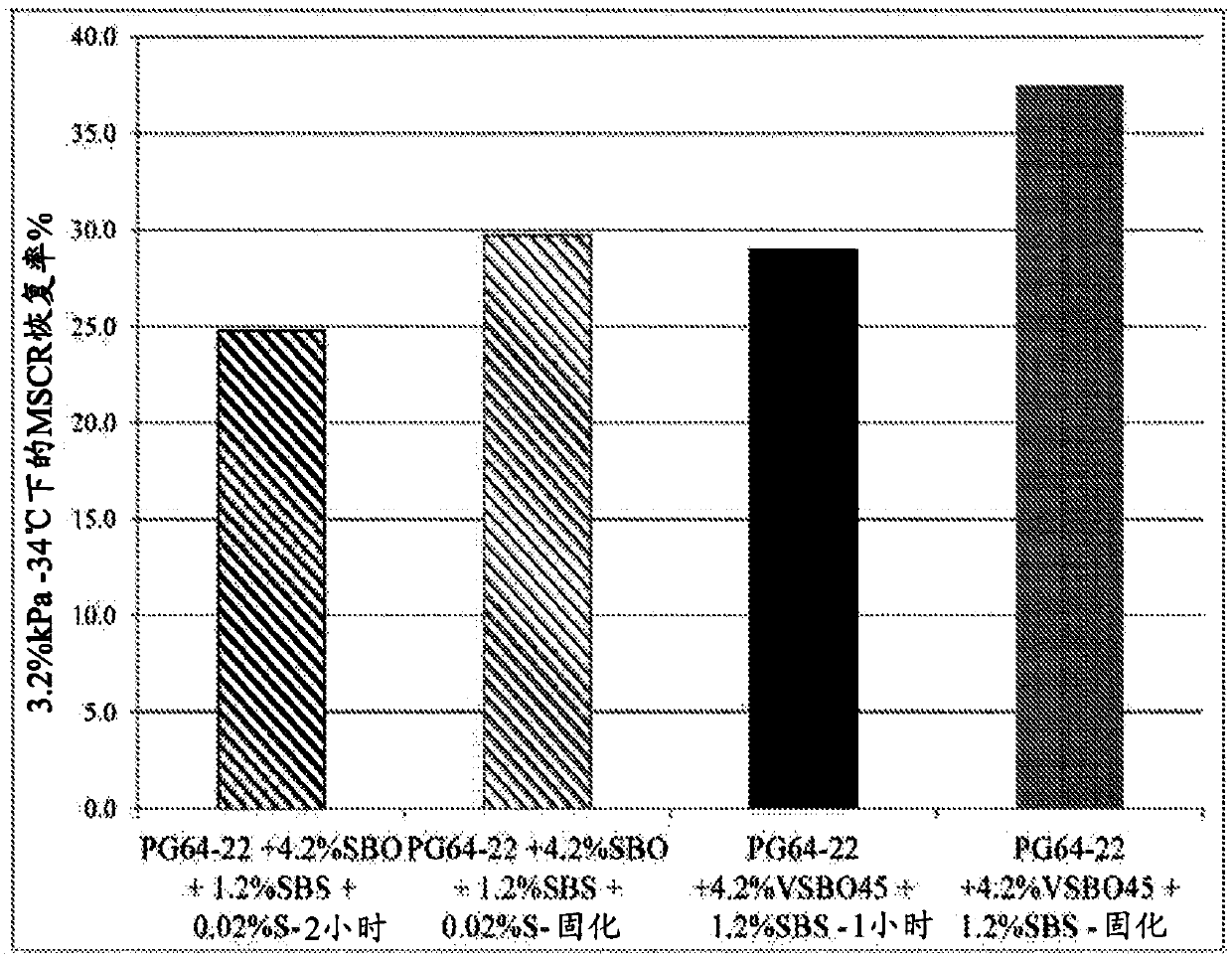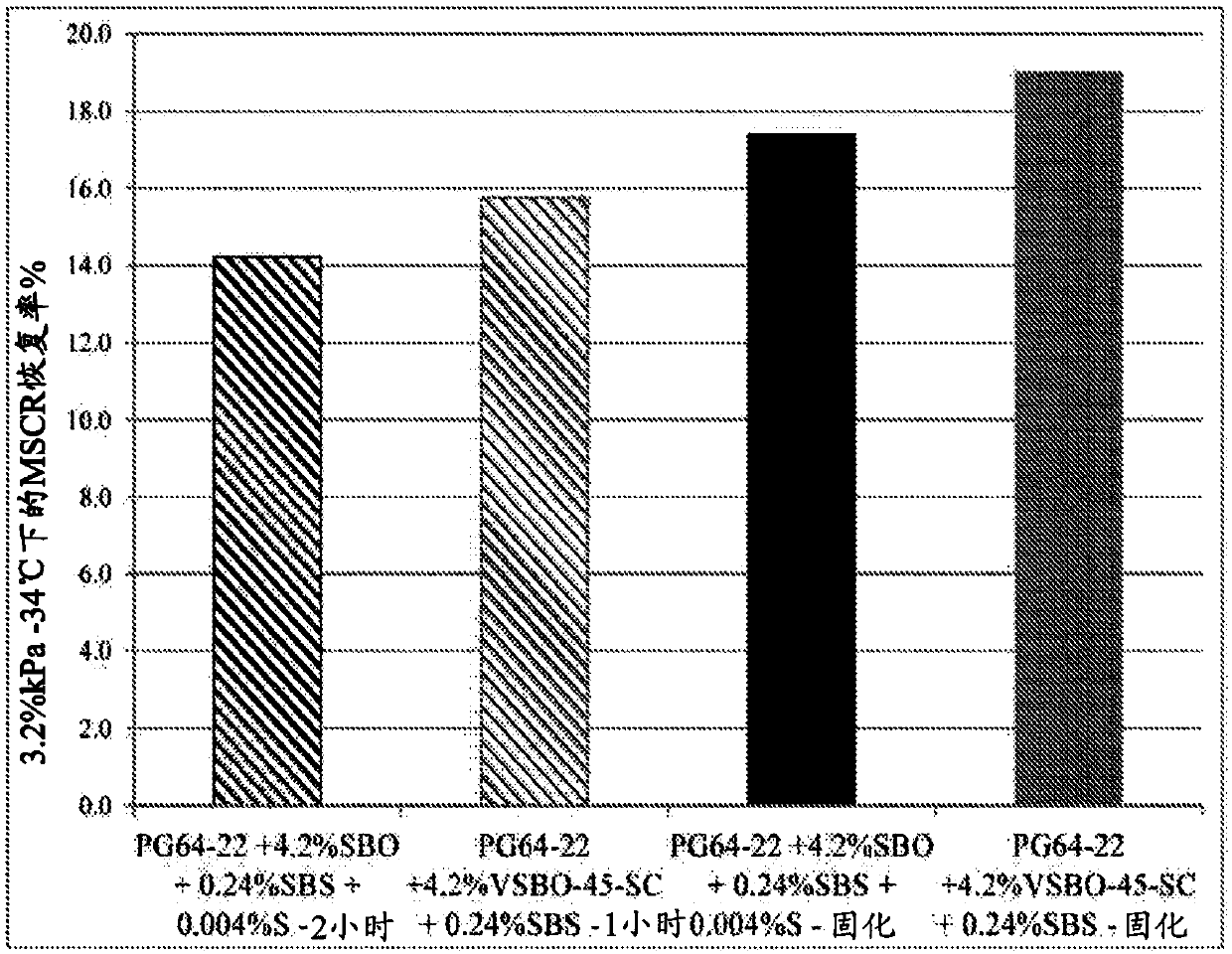Composite thermoplastic polymers based on reaction with biorenewable oils
A technology of thermoplastic polymers and polymers, which can be applied in the direction of on-site paved concrete pavement, building construction, roads, etc., and can solve problems such as performance enhancement
- Summary
- Abstract
- Description
- Claims
- Application Information
AI Technical Summary
Problems solved by technology
Method used
Image
Examples
Embodiment 1
[0078] Example 1: Use of sulfurized vegetable-based oils as polymer compatibilizers and crosslinkers
[0079] Two polymer-modified asphalt blends were compared: one in which elemental sulfur was added directly to the asphalt to crosslink the SBS (blend A) after the conventional asphalt polymer modification procedure, and the other in which A sulfurized vegetable-based oil without crosslinker was added to the bitumen prior to SBS (blend B).
[0080] The Multiple Stress Creep and Recovery procedure under AASHTO T350 is a procedure designed to measure the elasticity of asphalt binders by repeating the 1-second creep and 9-second recovery steps. This procedure is particularly useful for evaluating the performance of polymer-modified asphalts. Using the strain responses from the creep and recovery steps, percent recovery (R%) was calculated as a measure of the ratio of recoverable strain during the 9 second recovery period to the total strain applied at the end of the 1 second c...
Embodiment 2
[0104] Example 2: Use of sulfurized vegetable-based oils as polymer compatibilizers and crosslinkers:
[0105] Two polymer-modified asphalt blends were compared: one in which elemental sulfur was added directly to the asphalt to crosslink the SBS (blend A) after the conventional asphalt polymer modification procedure, and the other in which A sulfurized vegetable-based oil without crosslinker was added to the bitumen prior to the polymer (blend B).
[0106] Blend A is a modified asphalt binder comprising:
[0107] • 95.56% pure asphalt binder graded PG64-22 (PG 65.7-24.9) by weight of the blend.
[0108] • 4.2% refined soybean oil by weight of the blend.
[0109] • 0.24% styrene-butadiene styrene (Kraton D-1192) by weight of the blend.
[0110] • 0.004% elemental sulfur by weight of the blend.
[0111] Blend B is a modified asphalt binder comprising:
[0112] • 95.56% pure asphalt binder graded PG64-22 (PG 65.7-24.9) by weight of the blend.
[0113] • 4.2% sulfurized r...
Embodiment 3
[0125] Example 3: Use of sulfurized vegetable-based oils as polymer compatibilizers and crosslinkers:
[0126] Two polymer-modified asphalt blends were compared: one in which elemental sulfur was added directly to the asphalt to crosslink the SBS (blend A) after the conventional asphalt polymer modification procedure, and the other in which A sulfurized vegetable-based oil without crosslinker was added to the bitumen prior to the polymer (blend B).
[0127] Blend A is a modified asphalt binder comprising:
[0128] • 95.56% pure asphalt binder graded PG64-22 (PG 65.7-24.9) by weight of the blend.
[0129] • 4.2% refined soybean oil by weight of the blend.
[0130] • 0.24% styrene-butadiene styrene (Kraton D-1192) by weight of the blend.
[0131] • 0.004% elemental sulfur by weight of the blend.
[0132] Blend B is a modified asphalt binder comprising:
[0133] • 95.56% pure asphalt binder graded PG64-22 (PG 65.7-24.9) by weight of the blend.
[0134] 4.2% polymeric vege...
PUM
| Property | Measurement | Unit |
|---|---|---|
| Melting point | aaaaa | aaaaa |
| Acid value | aaaaa | aaaaa |
Abstract
Description
Claims
Application Information
 Login to View More
Login to View More - R&D
- Intellectual Property
- Life Sciences
- Materials
- Tech Scout
- Unparalleled Data Quality
- Higher Quality Content
- 60% Fewer Hallucinations
Browse by: Latest US Patents, China's latest patents, Technical Efficacy Thesaurus, Application Domain, Technology Topic, Popular Technical Reports.
© 2025 PatSnap. All rights reserved.Legal|Privacy policy|Modern Slavery Act Transparency Statement|Sitemap|About US| Contact US: help@patsnap.com



